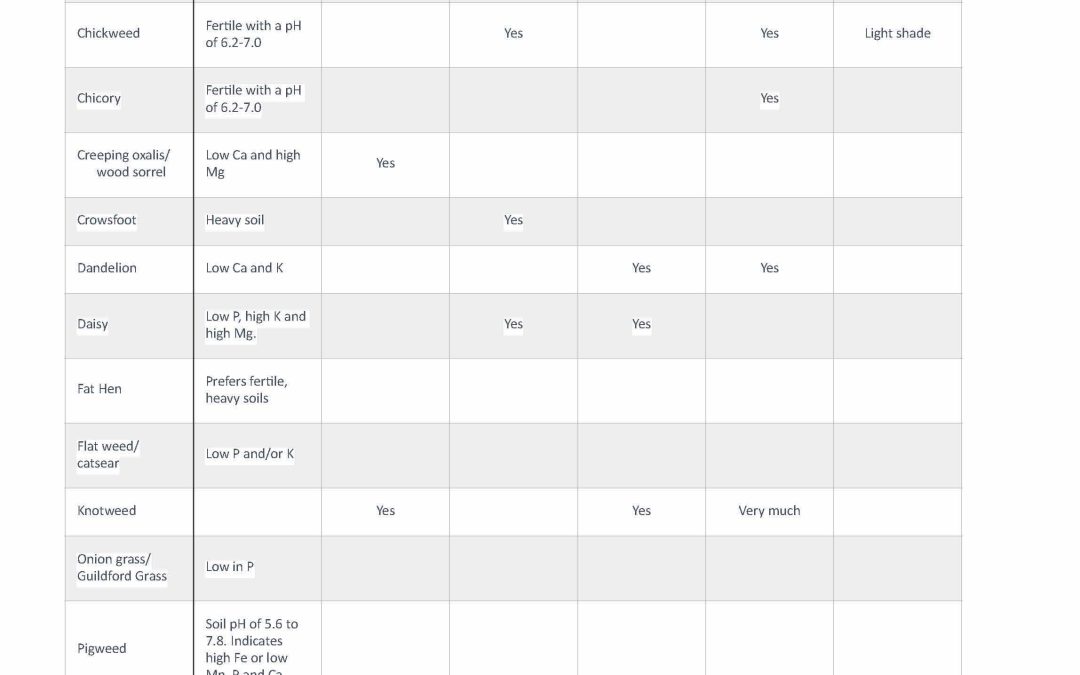What Weeds Tell Us About the Soil.
Weeds are great indicators of soil conditions and environmental indicators. You can use this fact to help create the best possible conditions for your lawns and turf grass.
- What weeds are present has a direct effect on what herbicides to use. This is a key factor that impacts herbicide selection in turf management.
- Weeds indicate soil conditions. Using them as indicator weeds is the first step to identify what may limit turf growth.
- Don’t make any decision based on the presence of one weed. For example, some weeds like Sorrel like a wide range of soil conditions.
Weeds as indicators of wet soil conditions.
Plants like cat-tails, bulrushes (Cumbungi), and sedges show wet soils.
- Yellow Nutsedge.
- Common Purslane.
- Horsetail.
- Mallow
- Speedwell
- Scarlet Pimpernell
- Oxalis sp
- Knotgrass
- Dock
- Creeping Buttercup
- Mosses
- Bittercress or Flickweed and
- Rushes.
Weeds and what they tell us about soil fertility.
Indicators of poor soil
- White Clover is a weed indicator of low fertility soil. It is a nitrogen-fixing plant that thrives in low-nutrient soils.
- Inkweed.
- Black Medic thrives in low-nutrient soils.
- The presence of redroot pigweed means that the Fe-Mn ratio is out of balance.
- Summergrass shows low levels of Ca and P and high levels of Mg and K.
- Dandelions show low Ca and very high levels of K.
- Oxalis sp shows low levels of Ca, and high levels of Mg.
Indicators of rich soil
- Stinging Nettles are weed indicators of nitrogen-rich soils.
- Chickweed shows nitrogen-rich soil. It also indicates very low Ca and P levels and very high K and Na levels.
- Chicory favours high nitrogen soils and so do lambs quarters
- Knapweed shows high soil K.
- Both Mustard and Purslane indicate high P levels.
- Speedwell.
- Shepherds purse
- Henbit
- Dandelion
- Canada thistle
- Fat Hen thives in high K soils.
What Weeds Tell us about disturbed soils.
Weed indicators of disturbed soils, include fireweed.
- Common Ragweed
- Shepherd’s Purse
- Field Thistle
- Japanese Knotweed
- Red root Pigweed
- Knapweeds
- Prickly Lettuce
- Horsetail
- Wild Mustard
- Bittercress or Flickweed and
- Ox-Tongue
Environmental indicators:
Certain plants, such as mosses and lichens, are useful bioindicators of air quality and pollution. For instance, lichens are sensitive to air pollution.
What Weeds tell us about Indicators of Soil pH.
Some weeds prefer acidic or alkaline soils. For example, mossy stonecrop (Sedum acre) grows well in acidic soils. In contrast, alkali grass funnily enough loves alkaline soils.
Acid soils (low pH).
- Oxalis.
- Plantain.
- Summergrass.
- Velvet weed.
- Ox-eye daisies.
- Pearly everlasting.
- Sheep sorrel.
- Wild radish and
- and prostrate knotweed.
Alkali soils (high pH).
- Chickweed.
- Chicory.
- Wild mustard and
- Black medic
What Weeds tell us about Compaction:
- Broadleaf plantain is a weed indicator of compact soil
- Ground Ivy.
- Dandelion.
- Crowsfoot is found on compact sports turf in warm-season grasses.
- Burdock has deep tap roots and likes compact soil.
- Bindweed.
- Spurge
- Chickweed
- Chicory.
- Knotweed is an excellent indicator of compaction.
- Inkweed will grow in heavy clay or compact soil.
- Bindii.
- Creeping Mallow
Shade:
- Speedwell
- Ground Ivy and
- Chickweed.

Jerry Spencer
Jerry has an Hons Degree in Soil Science (1988) from Newcastle Upon Tyne University. He then worked as a turf agronomist for the Sports Turf Research Institute (STRI) until 1993.
He gained a Grad Dip in Business Management from UTS in 1999. He has held a number of technical roles for companies such as Arthur Yates (Commercial Technical Manager) and Paton Fertilizers (Organic, turf specialty and controlled release fertiliser) portfolios.
In 2013 he established Gilba Solutions as independent sports turf consultants and turf agronomists. Jerry has written over 100 articles and two books on a wide range of topics such as Turf Pesticides and turfgrass Nutrition which have been published in Australia and overseas.


